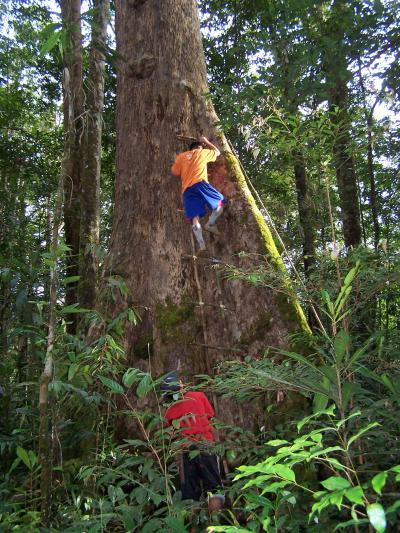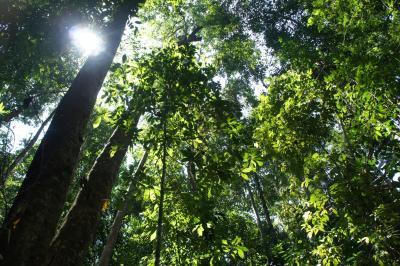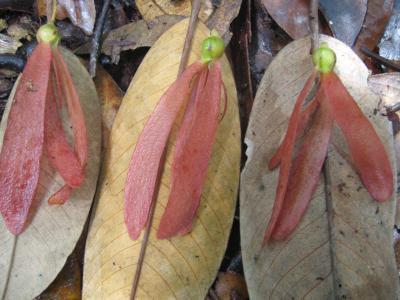A team of scientists has found that the woody growth of forests in north Borneo is half as great again as in the most productive forests of north-west Amazonia, an average difference of 3.2 tons of wood per hectare per year.
The new study, published today in the Journal of Ecology, examined differences in above-ground wood production (one component of the total uptake of carbon by plants) which is critically important in the global cycling of carbon.
Trees are taller for a given diameter in Southeast Asia compared with South America, meaning they gain more biomass per unit of diameter growth, and this in part explains the differences observed.
The research team also discovered that trees in north Borneo belonging to the family Dipterocarpaceae (or dipterocarps, translating literally to "winged seeds"), which grow to giant sizes, produced wood faster than neighbouring trees of other families, or any trees in the Amazonian sites.
Whilst regional variation in wood production rates has been suspected, this research, carried out by an international collaboration of scientists from the UK, Asia, South America and USA, is the first to use identical methods in Amazonia and Borneo to measure properties of both the forests and their soils, making robust comparisons among different continents possible for the first time.

This image shows measuring the diameter of a large tree in a dipterocarp forest (Gunung Mulu, Sarawak). The buttress root helps support its great weight.
(Photo Credit: Lindsay Banin/Centre for Ecology & Hydrology)
The two regions were compared as they are climatically similar with no annual dry season, and each region has a range of soil conditions, meaning the primary difference between them is the different tree species that happen to exist in each region.
Above-ground wood production is the amount of biomass gained in the woody parts of a tree. It can be estimated from repeated measures of tree diameter and estimates of wood density and tree height. The study examined data from 26 hectares of forest and 12,000 trees which have been monitored for more than twenty years.
Lead author Dr Lindsay Banin from the UK's Centre for Ecology & Hydrology said, "In Borneo, dipterocarps – a family of large trees with winged seeds - produce wood more quickly than their neighbours. This means that they have evolved something special and unique - what exactly this is remains a mystery. Dipterocarps are known to make special relationships with fungi in the soil, so they may be able to tap into scarce nutrient resources. Or, they may be trading-off growth of other plant parts."

A seedling's view: the sandstone rainforest at Sepilok Nature Reserve, Sarawak.
(Photo Credit: Lindsay Banin/Centre for Ecology & Hydrology)
Co-author Professor Oliver Phillips from the University of Leeds said, "One big question in ecology is whether plant species composition matters at all to fundamental ecosystem functions such as productivity, or carbon storage. The fact that dipterocarp-dominated forests achieve faster wood growth than even the most diverse forests in the Amazon shows that the random evolutionary histories of continents can determine their whole ecology. Identity really does matter."
With growing global datasets collected using standardised methods, further comparisons will be possible across the tropics to help elucidate the nature and causes of variation in plant biomass growth. Understanding variation in the capacity for forests to store and sequester carbon is vitally important for managing them best to keep carbon out of the atmosphere.

The characteristic winged fruits of the dipterocarp family -- trees in North Borneo are shown.
(Photo Credit: Jugah Tagi)





Comments